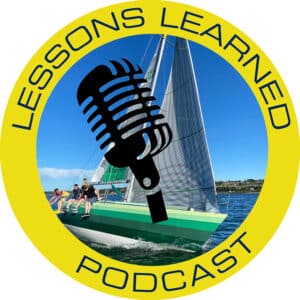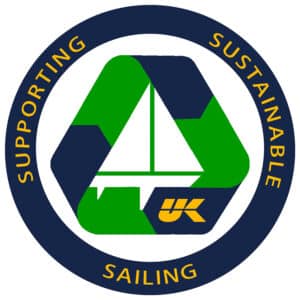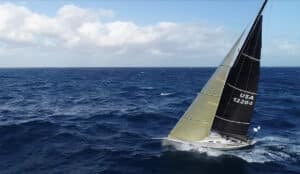After multiple, well-reported incidents of failed man overboard recovery attempts, the thought leaders within the world of safety at sea are evolving their thinking regarding the best way to recover someone in the water. The traditional side pick-up method, long the primary technique taught, is being replaced by recoveries using the LifeSling. The chances of a successful MOB recovery increases when the first recovery attempt is successful. Therefore, it is now recommended to use your engine to get back to the person as fast as possible and then use the LifeSling to connect to and to pull the person back aboard. If the person in the water is conscious, the LifeSling is the safest MOB recovery method.
The Lifesling can be used in two ways. The traditional method is to drop it over your stern, let the 150 feet of polypropene line pay out while steering around the MOB to bring the tow line and horseshoe to the MOB. This is similar to bringing the tow rope to a water skier. Instead of needing pin-point accuracy, the LifeSling gives you larger window of opportunity to recover an MOB. With the long floating line, you just have to get it to the person in the water. Once the sailor in the water puts the horseshoe over his or her shoulders, they are physically attached to the boat. Then you can stop the boat, pull them in, attach a halyard and winch them back aboard.
There is a second way to recover someone with the Lifesling, and it’s faster. Once some goes overboard, tack the boat and backwind the jib to stop the boat. Check for lines in the water, start the engine and return to the person under power. Pull abeam or slightly upwind and then toss the LifeSling to the MOB as if the LifeSling was a throw rope. This saves the time of circling the long line around. Keeping the boat 5-15 feet away from the person, which means you can use your engine without the risk of hitting the MOB with the boat or hurting them with the spinning propeller.
Here is a trick to using the LifeSling more effectively. Tie a bowline in the Lifesling line —10 to 15 feet up from the horseshoe. This lets you attach the halyard before the person is along-side the boat. The more time they are in the water next to the boat, the more chance they have of getting hurt. Tying a loop in the tow line also keeps you from having to lean over the life lines to attach the halyard. Leaning over the life lines makes you vulnerable to falling overboard yourself.
Finally, a quick word on rigging the LifeSling and repacking it. The Lifesling comes in a rectangular bag that attaches to the stern pulpit with Velcro straps. The straps just hold the bag, not the person in the water. Therefore, be sure to tie the dead end of the LifeSling line to one of the legs of the pulpit with a bowline. The last six feet of the line is covered with webbing to protect the polypropelyne line from the UV rays of the sun. Only the covered part of the line should be outside the bag.
It’s worth noting that racing sailors spend a lot of time practicing tacks and gybes before racing with new crew members; with that in mind, it makes sense to practice LifeSling recoveries more than once a year. On a warm summer’s day, have someone jump in and try the two different LifeSling recoveries. You will be surprised how much you learn. Repacking the LifeSling can be done in a few minutes on the boat. It does not have to be sent away to be repacked like the MOM8. It’s important to practice on your boat since all boats turn, slow and accelerate differently. Remember, the life you save may be your own.
Some of the footage in the video comes from the Storm Trysail Foundation’s Man Overboard Recovery Video, which was produced for Storm Trysail Foundation by Gary Jobson. The Storm Trysail Foundation runs several hands-on Safety At Seminars throughout the year, with the biggest one at New York Maritime in May. Attendee’s get access to nearly a dozen videos that Gary Jobson created to supplement the class. For more information go to: www.stormtrysailfoundation.org



